封装 MyBatis 输出结果
resultType
resultType: 执行sql 得到 ResultSet 转换的类型,使用类型的完全限定名或别名。 注意如果返回的是集合,那应该设置为集合包含的类型,而不是集合本身。resultType 和 resu ltMap,不能同时使用。
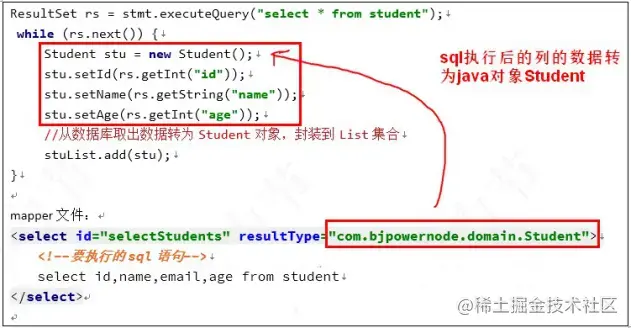
A、 简单类型
接口方法:
int countStudent();
mapper 文件:
< select id="countStudent"
resultType="int"> select count(*) from
student
< /select>
复制代码测试方法:
@Test
public void testRetunInt(){
int count = studentDao.countStudent();
System.out.println("学生总人数:"+ count);
}
复制代码B、对象类型
接口方法:
Student selectById(int id);
mapper 文件:
<select id="selectById"
resultType="com.bjpowernode.domain.Student"> select
id,name,email,age from student where id=#{studentId}
</select>
复制代码框架的处理: 使用构造方法创建对象。调用setXXX 给属性赋值。
Student student = new Student();
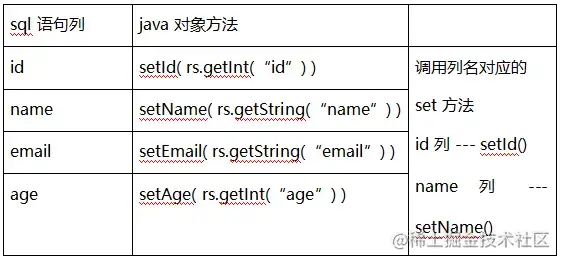
注意:Dao 接口方法返回是集合类型,需要指定集合中的类型,不是集合本身。

C、Map
sql 的查询结果作为 Map 的key 和value。推荐使用Map<Object,Object>。
注意:Map 作为接口返回值,sql 语句的查询结果最多只能有一条记录。大于一条记录是错误。
接口方法:
Map<Object,Object> selectReturnMap(int id);
mapper 文件:
<select id="selectReturnMap" resultType="java.util.HashMap">
select name,email from student where id = #{studentId}
</select>
复制代码测试方法:
@Test
public void testReturnMap(){
Map<Object,Object> retMap = studentDao.selectReturnMap(1002);
System.out.println("查询结果是 Map:"+retMap);
}
复制代码resultMap
resultMap 可以自定义sql 的结果和 java 对象属性的映射关系。更灵活的把列值赋值给指定属性。
常用在列名和java 对象属性名不一样的情况。
使用方式:
1.先定义resultMap,指定列名和属性的对应关系。
2.在< select>中把 resultType 替换为resultMap。
接口方法:
List< Student> selectUseResultMap(QueryParam param);
mapper 文件:
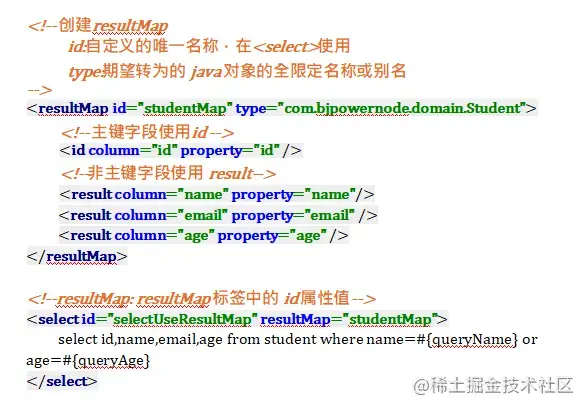
测试方法:
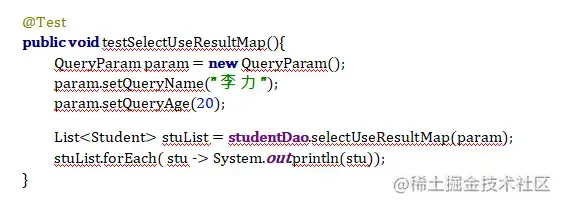
实体类属性名和列名不同的处理方式
(1) 使用列别名和< resultType>
步骤:
1. 创建新的实体类 PrimaryStudent
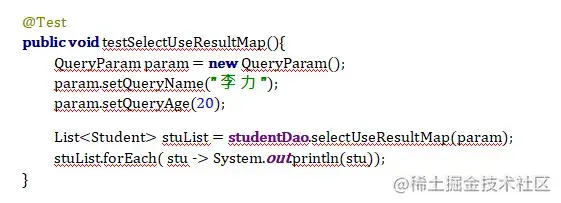
2. 接口方法
List< PrimaryStudent> selectUseFieldAlias(QueryParam param);
3. mapper 文件:
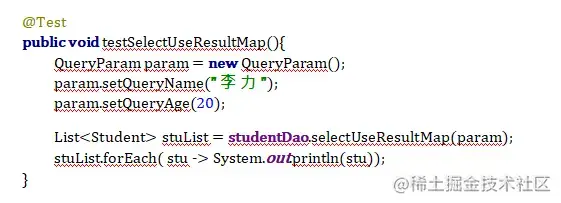
4. 测试方法
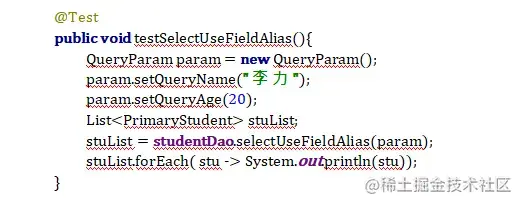
(2) 使用< resultMap>
步骤:
1. 接口方法
List<PrimaryStudent> selectUseDiffResultMap(QueryParam param);
2. mapper 文件:
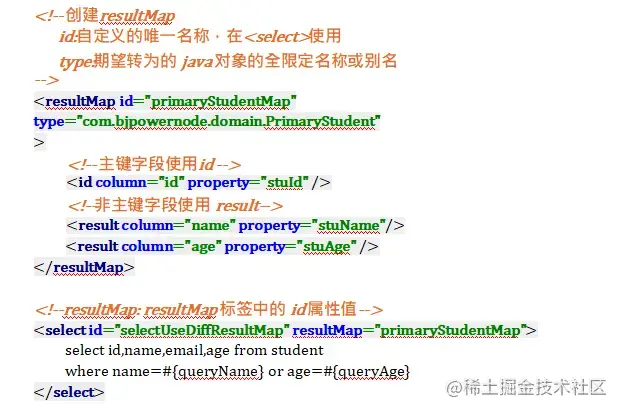
3. 测试方法
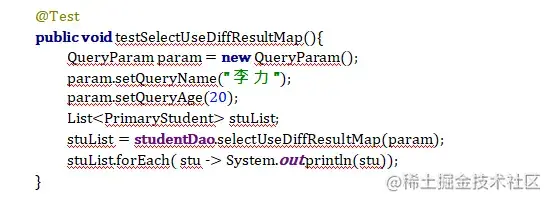
模糊 like
模糊查询的实现有两种方式, 一是java 代码中给查询数据加上“%” ; 二是在mapper 文件sql 语句的条件位置加上“%”
需求:查询姓名有“力”的
例 1: java 代码中提供要查询的 “%力%”
接口方法:
List<Student> selectLikeFirst(String name);
mapper 文件:
<select id="selectLikeFirst"
resultType="com.bjpowernode.domain.Student"> select
id,name,email,age from student
where name like #{studentName}
</select>
复制代码测试方法:
@Test
public void
testSelectLikeOne(){ String
name="%力%";
List<Student> stuList = studentDao.selectLikeFirst(name);
stuList.forEach( stu -> System.out.println(stu));
}
复制代码例 2:mapper 文件中使用 like name "%" #{xxx} "%"
接口方法:
List<Student> selectLikeSecond(String name);
mapper 文件:
<select id="selectLikeSecond"
resultType="com.bjpowernode.domain.Student"> select id,name,email,age
from student
where name like "%" #{studentName} "%"
</select>
复制代码测试方法:
@Test
public void
testSelectLikeSecond(){ String
name="力";
List<Student> stuList = studentDao.selectLikeSecond(name);
stuList.forEach( stu -> System.out.println(stu));
}
作者:凌小可可
链接:https://juejin.cn/post/7021350272463011870
来源:稀土掘金
著作权归作者所有。商业转载请联系作者获得授权,非商业转载请注明出处。
最后
以上就是拉长萝莉最近收集整理的关于IDEA这样配置,好用到爆炸!!!封装 MyBatis 输出结果的全部内容,更多相关IDEA这样配置,好用到爆炸!!!封装内容请搜索靠谱客的其他文章。








发表评论 取消回复